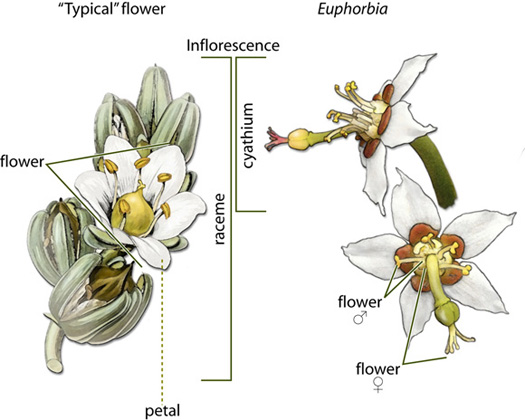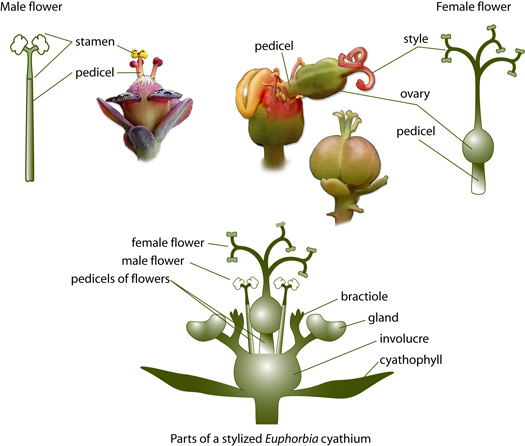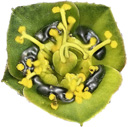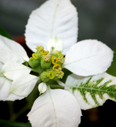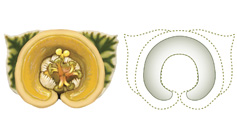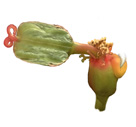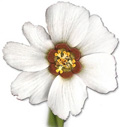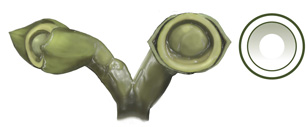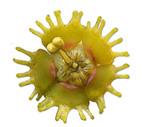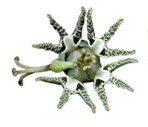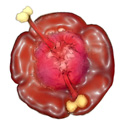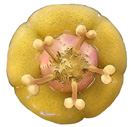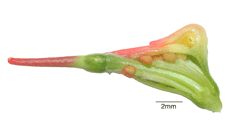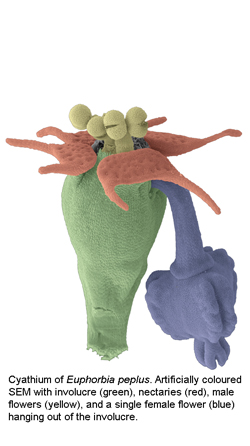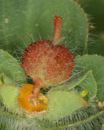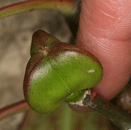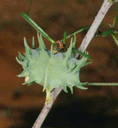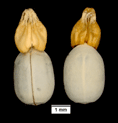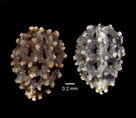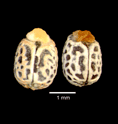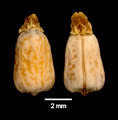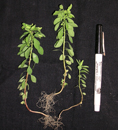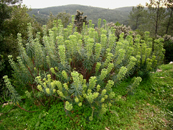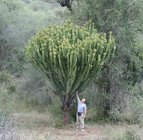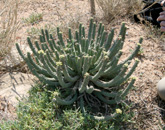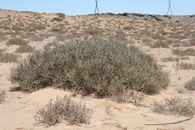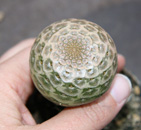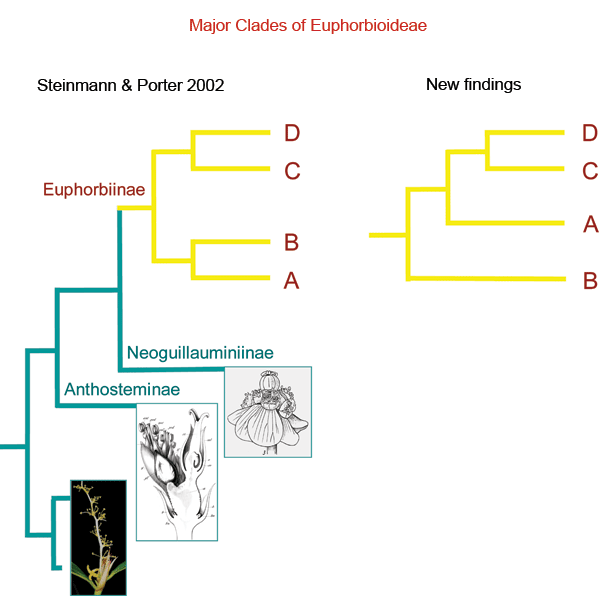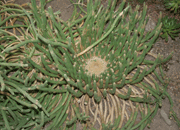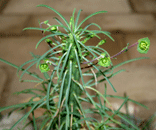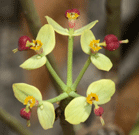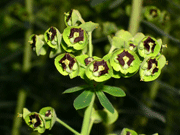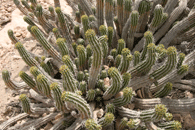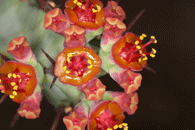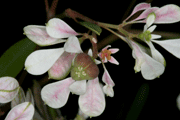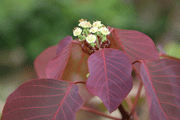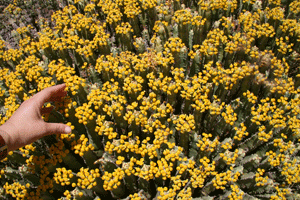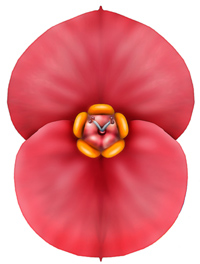
|
About the genus Euphorbia | ||||||||||||||||||||||||||||||||||||||||||||||||||||||||||||||||||||||||||||||||||||||||||||||||||||||||||||
Home Project Participants About Euphorbia Fieldwork News Data Portal Interactive Key Links Contact Us |
What makes a Euphorbia | Origin of the cyathium | Fruits and seeds | Diversity of life forms | Uses and toxicity | Systematics and classification | The botanical name Euphorbia | Common names Euphorbia is a genus of plants in the Euphorbiaceae
family. It contains at least 2,100 species and is one of the most diverse groups of flowering
plants on earth. Many of the species are known as "spurges." They all produce a mostly
white latex which they exude when cut, and this sap is often toxic. There are many
herbaceous spurges, especially in temperate zones worldwide, but the genus is best
known for its many succulent species, some of which appear very similar to cacti.
Succulent euphorbias are most diverse in southern and eastern Africa and Madagascar,
but they also occur in tropical Asia and the Americas. All flowers in the Euphorbiaceae are unisexual (either male
or female only), and they are often very small in size. In Euphorbia, the flowers are reduced
even more and then aggregated into an inflorescence or cluster of flowers known as a
"cyathium" (plural cyathia). This feature is present
in every species of the genus but nowhere else in the plant kingdom. Whereas most other
large genera of plants differ in features of the flowers themselves, Euphorbia varies instead in features of the
cyathium, which can show amazing modifications in different groups within
the genus.
The main defining feature of the cyathium is the floral envelope or involucre that surrounds each group of flowers. The involucre almost always has one or more special glands attached to it, most often on the upper rim, and these glands and their appendages vary greatly in size and shape. There may be specialized leaves called cyathophylls or cyathial leaves that surround the cyathium and give an overall flower-like appearance to the whole complex inflorescence. Inside the involucre are the flowers, usually with a number of extremely simplified male flowers consisting of a single anther, filament, and pedicel. Generally there is a single female flower in the center consisting of a pedicel, a three-parted ovary, and no petals or sepals associated with it.
With this basic model of the cyathium, many modifications upon it have evolved in the genus, as well as in the aggregation of cyathia into higher order units. Some of the variations are described below: 1. Cyathia can differ widely in the presence of associated bracts or cyathophylls. In other cases, such as E. pulcherrima (Poinsettia), normal leaves below the cyathia turn color and add to the overall display of the groups of cyathia in the center. There are also many Euphorbia species in which cyathophylls and colored bracts are absent.
2. The number and forms of involucral glands as well as gland appendages varies enormously as shown by these examples below.
3. Cyathia are often aggregated into more complex units (synflorescences), usually based on an inflorescence model called a cyme or an umbel. 4. In terms of symmetry, cyathia can be essentially actinomorphic, with many planes of symmetry, or slightly or strongly zygomorphic (bilaterally symmetrical, with only one plane of symmetry).
Fruits of Euphorbia are capsules that typically split open explosively when ripe. There are potentially three seeds per capsule, and there is a wide variety of size, shape, and surface features of the seeds and capsules. Seeds of some species have a fleshy appendage called the caruncle above the point of attachment to the central column of the fruit.
The variety of habits or life forms is one of the most
salient features of Euphorbia. There are many annual or perennial herbs, and these tend
to retain leaves through their active growing periods. At its simplest, in a number of
species in the Chamaescyce lineage, the plant will germinate, dichotomously branch,
flower, fruit, and die in a matter of weeks. There are also leafy shrubs and trees
species that can reach 20 meters high. A large portion of euphorbias, however, are
succulent, with thickened, photosynthetic stems and very ephemeral leaves if present
at all. Many succulents are in turn thorny, and some have well developed underground
tubers. Here we show a small representation of Euphorbia life forms:
The main uses of spurges are horticultural. There are
hundreds of cultivars of Poinsettia (E. pulcherrima), and this is the most widely grown
pot plant in Europe, the United States, and other countries for the Christmas holiday
season. There are also many herbaceous species that are cultivated, such as Snow on the
Mountain (E. marginata), Caper spurge (E. lathyris), Cypress spurge (E. cyparissias),
sun spurge (E. helioscopia), and Mediterranean spurge (E. characias). Among the succulent
or thorny species, E. trigona is the most widely grown cactiform euphorbia, and
Crown-of-thorns (E. milii) is very widely grown in warmer climates and greenhouses.
Euphorbia obesa is a commonly cultivated globoid and thornless species. The Pencil tree
of Milk bush (E. tirucalli) is also grown horticulturally, but it is widely used in
Africa and India as an easily propagated hedgerow plant. Euphorbia tithymaloides is an
American native that is widely grown in warm climates worldwide. Euphorbia cotinifolia
and E. laurifolia are also used as living fences in several countries of tropical America. Some species of Euphorbia have been used in folk medicine over
the centuries, especially in the Euphorbia esula alliance. Latex of E. cooperi and
E. ingens has been used locally in Africa to stun fish; grass soaked in latex is thrown
into a pond and the fish then rise to the surface. Candelilla wax is obtained from
E. antisyphilitica and used as a food additive, glazing agent, and component of lip
balm. The milky sap or latex of spurges is suggested to have
a protective and defensive role in helping heal wounds and in deterring potential
plant-eaters. There is a wide variety of chemical compounds present in Euphorbia sap,
and some of them are toxic and potentially carcinogenic. Compounds known as terpene
esters are common and often account for the extremely
caustic and irritating properties of the milky sap, either by direct contact with the
skin or even by exposure to the air and inflammation of the eyes or mucous
membranes. Systematics and classification Our understanding of the relationships of Euphorbia has been bolstered by comparative DNA sequence data from many species, and these results support a broad view of the genus that includes a number of groups that were formerly recognized as different genera, such as Chamaesyce, Monadenium, Pedilanthus, and Poinsettia. The most current information places Euphorbia species into four distinct monophyletic groups or clades. Recent work by Kenneth Wurdack and Benjamin Van Ee has examined 15 different regions from the three plant genomes (nuclear, chloroplast, and mitochondrial), and this now shows clear support for the following relationships among the four main clades of Euphorbia: clade B (subgenus Esula) is the sister group to clade A (subgenus Rhizanthium), and that is in turn sister to both clades C and D (subgenus Euphorbia and subgenus Chamaesyce). The implications of this finding for understanding the evolution of Euphorbia are significant, and further understanding the phylogenetic relationships within subgenus Esula may help us understand where and how the genus evolved and spread to its current worldwide distribution.
Clade A (Subgenus Rhizanthium)
Clade B (Subgenus Esula)
Clade C (Subgenus Euphorbia)
Clade D (Subgenus Chamaesyce)
Origin of the botanical (Latin) name Euphorbia Euphorbia became the official botanical name for the genus when Carolus Linnaeus published it in the first edition of his book Species Plantarum, in 1753 (p. 450). The name, however, goes much farther back in history, and we can trace its origin at least as far back as the Roman officer Pliny the Elder, who named Euphorbia in his book, the Natural History of Pliny (79 AD). Pliny studied botany in his youth and was tutored in Rome by Juba II, the son of Juba I, King of Numidia (a northern Africa kingdom in part of present-day eastern Algeria). According to Pliny, after Juba moved to Mauretania,
Meaning of the common name "spurge" Many of the herbaceous, leafy species of Euphorbia are commonly called "spurges." This word derives from the Old French word espurgier (Latin expurgare), which means "to purge." The sap of many herbaceous Euphorbia species have traditionally been used as a purgative, or laxative. Other common names in Euphorbia Threre are many local names for particular species of Euphorbia. "Poinsettia" is the much-used common name for Euphorbia pulcherrima cultivars, harking back to when the genus Poinsettia was used for this and related species. "Crown of thorns" is the English common name for Euphrobia milii cultivars. "Milkbush" or "pencil cactus" are both used for the much-cultivated Euphorbia tirucalli. Some other names used for different species of Euphorbia include "Snow-on-the-mountian", "Medusa's head", "Mexican fire plant", and "Scarlet plume". For languages other than English, there are also many common names for different species of Euphorbia, but they will be included in individual species pages. Page Credits: Digital art and illustrations: Kandis Elliot. Photos: Ricarda Riina, Jeff Morawetz, Paul Berry, Barbara Wagner, Thomas Haevermans, Gerhard Prenner, Manuel Portilheiro, Rikus van Veldhuisen, Ivalu Cacho, and Jinshuang Ma. Graphic of phylogenies: Ken Wurdack. Text: P. Berry, R. Riina, and J. Morawetz.
| © PBI Euphorbia Project | |||||||||||||||||||||||||||||||||||||||||||||||||||||||||||||||||||||||||||||||||||||||||||||||||||||||||||
